Tiny and soft-spoken, choreographer Lin Lee-chen (林麗珍) is the towering force behind her Legend Lin Dance Theatre (無垢舞蹈劇場).
She is famed for the stern discipline she imposes on the dancers and production team, her slow-motion choreography, an eagle eye attention to detail and the years she takes to create a new work. She demands a lot from the people she works with, as well as herself.
She can be equally demanding of audiences, as evidenced by the first section of her latest work, The Eternal Tides (潮), which premiered at the National Theater in Taipei on Wednesday last week.

Photo Courtesy of Michel Cavalca
It is a stunning 27-minute solo by lead dancer Wu Ming-jing (吳明璟), clad only in alabaster white body paint, a white thong and a massively long black wig, that involves reportedly more than 600 rotations.
Wu is first seen curled in a fetal position, back to the audience, exposed as the long white curtains that had covered the stage as the audience entered are ever so slowly raised.
She gradually shifts into a crouch, then a kneeling position, slowly raising her body until she is standing, all the while turning her head in circles that steadily widen until they consume her entire frame and the long tendrils of hair are whipping out around her as if they have a force of their own.
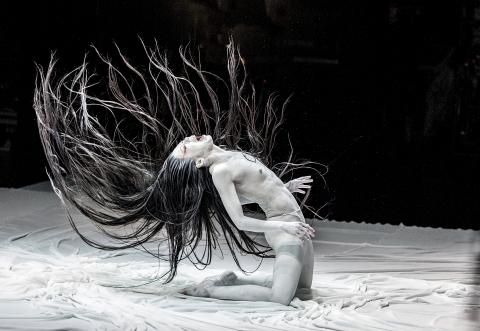
Photo Courtesy of Michel Cavalca
The longer it goes on the more concerned one feels for Wu and the strain she is imposing on her neck and the rest of her body, and yet you cannot help but marvel at the physical and mental discipline that allows her to keep going — as well as drummers Ho Yi-ming (賀毅明) and Hsiao Ying (蕭盈), sitting on either side of the stage keeping pace with Wu.
She rises, she falls, she gets back up again, over and over and over until she finally collapses with an incredible primal scream and lies writhing on the white cloth covering the floor, wailing and crying so hard her throat must be raw.
I saw last Saturday’s matinee and having attended the previous Wednesday press conference and photo call, I knew what was in store, and yet Wu — and Lin — overwhelmed me.
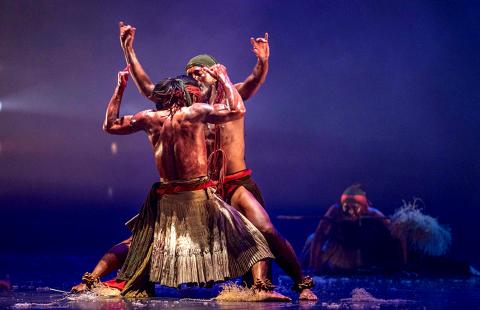
Photo Courtesy of Michel Cavalca
I felt the entire theater quieting as Wu’s solo went on — no rustling, body shifting or coughing — until the screaming was over.
I think the solo is Lin’s way of telling the audience that time moves on her terms in the performance, and however long it takes for her nine tableaux to unfold is how long it will take.
As in her previous trilogy about Heaven, Earth and Man, the dancers move, for the most part, incredibly slowly and deliberately, half crouched, one foot slowly raised, dragged forward and set down before the other begins to move. The choreography might seem to advance at a glacial pace, yet there is always so much happening, too many things to be captured in one viewing.
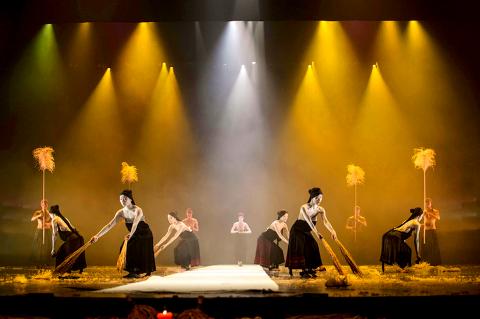
Photo Courtesy of Michel Cavalca
However, just when the slow tension might seem unbearable, there is an explosive release of energy, as with Wu’s screams or the primitive male-on-male fight scenes.
Cheng Chieh-wen (鄭傑文) reprises his role of Samao, one of the two eagle brothers, from Lin’s previous work, Song of Pensive Beholding (觀).
His duet with Wang Chien-yi (王芊懿), as White Bird, was the ritualistic mating dance of birds, their colorful plumage on full display, while Chen Chi-shun (陳啟順) danced the role of the other eagle brother.
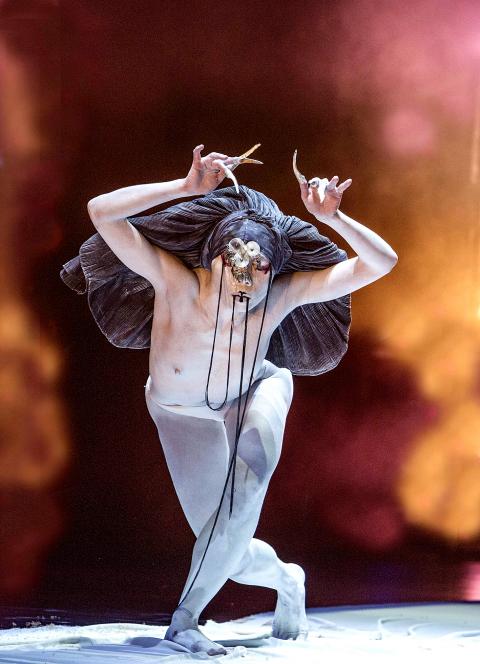
Photo Courtesy of Michel Cavalca
Wu makes a second stunning appearance, equally bare as the first, but with a black headress and three long fingerguards on each hand, for a solo in which she shifts from bird to Alien-like insect and back, talons clicking and dragging on the floor.
Lest one think that the cycle of life is all about feminine energy, there is the aggressive male posturing and clashes that could be territorial or simply about primacy.
Lin has said The Eternal Tides is about the cycle of tides, from drops of rainwater that fall into rivers and flow to the oceans and rise again into the clouds. I did not make that connection, but I was too enthralled by the world Lin has created on stage to care.
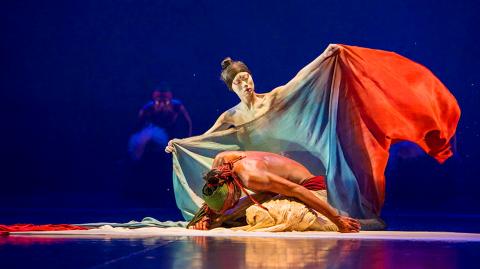
Photo Courtesy of Michel Cavalca
Lighting designer Cheng Kuo-yang’s (鄭國揚) work is terrific. The pitch black that surrounds Samao and White Bird in their duet imbues the colors of their bodies and costumes with luminous intensity, while the use of select spotlights and smoke turned the National Theater’s stage into an otherworldly temple, aided by Penny Tsai Pei-ling’s (蔡珮玲) stage design.
The haunting sounds of singer Hsu Ching-chwen (許景淳), who is seen briefly at the beginning enveloped in a massive white hood and wrap, provide an ethereal backdrop to the production.
As always with Legend Lin, the costumes by Wang Chia-hui (王佳惠), were simple yet beautiful, continuing with the Aboriginal and hill tribe motifs that Tim Yip (葉錦添) drew upon for Lin’s previous works.
The company will perform The Eternal Tides again in December at National Taiwan University of Arts in Banchiao District (板橋), New Taipei City, so those who missed the shows at the National Theater might considering marking their calendars now — otherwise it could be a couple of years before the production is seen again in Taiwan.

Cheng Ching-hsiang (鄭青祥) turned a small triangle of concrete jammed between two old shops into a cool little bar called 9dimension. In front of the shop, a steampunk-like structure was welded by himself to serve as a booth where he prepares cocktails. “Yancheng used to be just old people,” he says, “but now young people are coming and creating the New Yancheng.” Around the corner, Yu Hsiu-jao (饒毓琇), opened Tiny Cafe. True to its name, it is the size of a cupboard and serves cold-brewed coffee. “Small shops are so special and have personality,” she says, “people come to Yancheng to find such treasures.” She

The low voter turnout for the referendum on Aug. 23 shows that many Taiwanese are apathetic about nuclear energy, but there are long-term energy stakes involved that the public needs to grasp Taiwan faces an energy trilemma: soaring AI-driven demand, pressure to cut carbon and reliance on fragile fuel imports. But the nuclear referendum on Aug. 23 showed how little this registered with voters, many of whom neither see the long game nor grasp the stakes. Volunteer referendum worker Vivian Chen (陳薇安) put it bluntly: “I’ve seen many people asking what they’re voting for when they arrive to vote. They cast their vote without even doing any research.” Imagine Taiwanese voters invited to a poker table. The bet looked simple — yes or no — yet most never showed. More than two-thirds of those
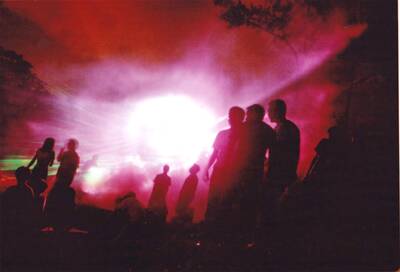
In July of 1995, a group of local DJs began posting an event flyer around Taipei. It was cheaply photocopied and nearly all in English, with a hand-drawn map on the back and, on the front, a big red hand print alongside one prominent line of text, “Finally… THE PARTY.” The map led to a remote floodplain in Taipei County (now New Taipei City) just across the Tamsui River from Taipei. The organizers got permission from no one. They just drove up in a blue Taiwanese pickup truck, set up a generator, two speakers, two turntables and a mixer. They

Former Chinese Nationalist Party (KMT) chairwoman Hung Hsiu-chu’s (洪秀柱) attendance at the Chinese Communist Party’s (CPP) “Chinese People’s War of Resistance Against Japanese Aggression and the World Anti-Fascist War” parade in Beijing is infuriating, embarrassing and insulting to nearly everyone in Taiwan, and Taiwan’s friends and allies. She is also ripping off bandages and pouring salt into old wounds. In the process she managed to tie both the KMT and the Democratic Progressive Party (DPP) into uncomfortable knots. The KMT continues to honor their heroic fighters, who defended China against the invading Japanese Empire, which inflicted unimaginable horrors on the